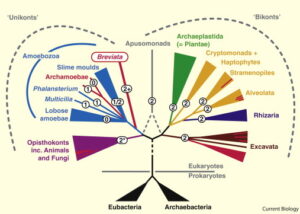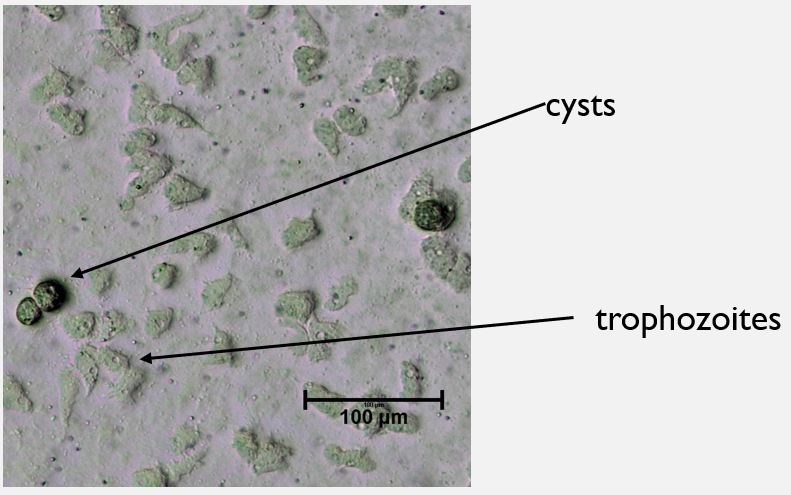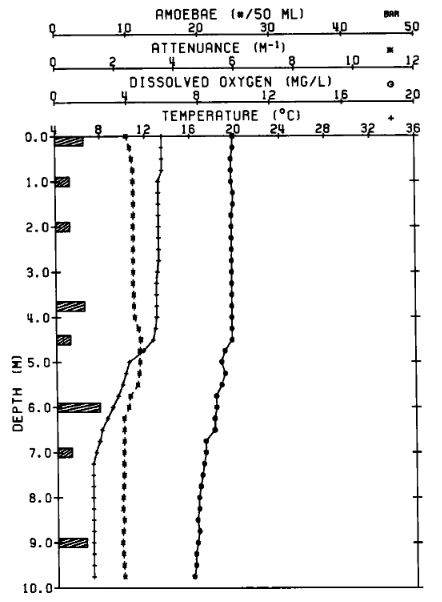
Free-living amoeba (FLA) are Eukaryotic organisms in the phylum Amoebozoa and the subphylum Lobosa. They live in a wide variety of environments around the world including soil, surface water, groundwater, and biofilms. They can exist either within a host, or free-living in the environment (which is what gives them their name). Several genera are potentially pathogenic to humans including Acanthamoeba, Balmuthia, Naegleria, Sappinia and Vermamoeba.
FLA have a two-stage life cycle: the trophozoite stage where they are metabolically active, feeding and dividing by binary fission, and the cyst stage where they are dormant. Research has shown that while in the cyst stage they are resistant to harsh environmental conditions like nutrient depletion, osmotic stress, temperature fluctuations, extreme pH, and water disinfection (Dupuy et al, 2014)

Acanthamoeba castellanii are one of the most prevalent FLA found in the environment (including soil; fresh, brackish, and sea water; field-grown vegetables; sewage; swimming pools; contact lens supplies; medicinal pools; dental treatment units; dialysis machines; heating, ventilating, and air conditioning systems; and tap water; mammalian cell cultures). A. castellanii can cause keratitis (especially in contact lens wearers) as well as fatal granulomatous encephalitis. The trophozoites are about 25 to 40 μm in diameter with characteristic spine-like pseudopodia. Cysts are double-walled, usually polygonal and spherical, and 15 to 20 μm in diameter. (Abdul Majid et al, 2017)
Surface Water Habitat

Soil and water are the primary habitat for FLA. In surface waters FLA live at the soil-water interface (sediment, particulate matter, animal and plant residue, etc) where they can feed on bacteria. If they are resuspended in the water column of a lake or reservoir they can settle to hypolimnion. Only amoeba who are resistant to anoxic and reductive conditions in cyst form will then survive.
Surface waters with high amounts of biomass will have larger bacterial populations that can support FLA (and protozoa in general). Large populations of FLA are found in sewage treatment systems due to the high amount of organic matter. FLA have also been found in air attached to suspended particulate matter. (Rodriquez-Zaragoza, 1994)
The vertical distribution of FLA in Lake Issaqueena, South Carolina in March 1983 by Kyle & Noblet (1985) shows that even after a cold winter FLA are found at very low depths in the lake.
References
- Abdul Majid et al. (2017). Pathogenic waterborne free-living amoebae: An update from selected Southeast Asian countries. PLoS One.
- Borniera, F., Zasa, E., Pothereta, D., Laaberki, M.-H., Coupat-Goutalanda, B., & Charpentier, X. (2021). Environmental Free-Living Amoebae Can Predate on Diverse Antibiotic-Resistant Human Pathogens. Applied and Environmental Microbiology, 87(18).
- Dupuy, M., Berne, F., Herbelinc, P., Binet, M., Berthelot, N., Rodier, M., . . . Hechard, Y. (2014). Sensitivity of free-living amoeba trophozoites and cysts to water disinfectants. International Journal of Hygiene and Environmental Health, 335-339.
- Kyle, D. E., & Noblet, G. P. (1985). Vertical distribution of potentially pathogenic free-living amoebae in fresh-water lakes. Journal of Protozoology.
- Rodriquez-Zaragoza, S. (1994). Ecology of Free-Living Amoeba. Critical Reviews in Microbiology, 225-241.
- Roger, A., & Simpson, A. (2009). Evolution: Revisiting the Root of the Eukaryote Tree. Current Biology, 165-167.